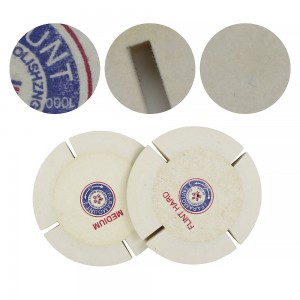Advancements in wool felt wheel technology are not only transforming the performance of the wheels themselves but also sending shockwaves through the entire polishing supply chain, from raw material suppliers to end – users. This ripple effect is reshaping the dynamics of the industry and creating new opportunities and challenges for all stakeholders involved.
At the upstream end of the supply chain, raw material suppliers are witnessing significant changes. As wool felt wheel manufacturers demand higher – quality and more specialized wool fibers, suppliers are investing in improved wool production and processing methods. This includes enhancing sheep breeding programs to produce wool with specific characteristics, such as longer staple lengths and higher strength, which are ideal for making durable and effective wool felt wheels. Additionally, suppliers are exploring alternative raw materials, such as synthetic fibers or recycled materials, to meet the growing demand for sustainable wool felt wheels. These changes in raw material sourcing are not only affecting the agricultural and textile sectors but also driving innovation in material science.
Wool felt wheel manufacturers, at the core of the supply chain, are at the forefront of these advancements. They are constantly researching and developing new manufacturing techniques to improve the performance, durability, and efficiency of their products. For example, the adoption of advanced bonding technologies is resulting in wool felt wheels with better fiber cohesion, reducing the risk of fiber shedding during use. New cutting and shaping methods are also being introduced to create wheels with more precise dimensions and geometries, ensuring a perfect fit for different polishing applications. These technological improvements not only enhance the competitiveness of wool felt wheel manufacturers but also enable them to offer more value – added products to their customers.
Downstream, distributors and retailers are also feeling the impact. As wool felt wheels become more specialized and technologically advanced, there is a greater need for knowledgeable sales staff who can understand the features and benefits of different products and provide expert advice to customers. Distributors are also adapting their inventory management systems to handle a wider variety of wool felt wheel models, including custom – designed ones. Online platforms are playing an increasingly important role in the distribution of wool felt wheels, as customers look for convenient ways to purchase specialized products. This has led to the development of new e – commerce strategies and partnerships between manufacturers, distributors, and online retailers.
For end – users, the advancements in wool felt wheels mean access to more efficient and effective polishing solutions. Whether it’s in the automotive, jewelry, or woodworking industries, users are benefiting from improved polishing performance, longer – lasting wheels, and greater customization options. However, with the increased complexity of wool felt wheel products, there is also a need for better user education and training. Manufacturers and distributors are now offering more comprehensive product information, tutorials, and after – sales support to help users make the most of their wool felt wheels.
In conclusion, the advancements in wool felt wheel technology are having a far – reaching impact on the entire polishing supply chain. From raw material sourcing to end – user applications, every segment of the supply chain is being forced to adapt and innovate. While these changes present challenges, they also offer significant opportunities for growth and collaboration, ultimately driving the evolution of the entire polishing industry.

Post time: Jun-13-2025
